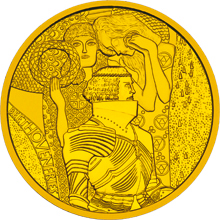Beethoven Frieze
[2] The frieze combined Ancient Greek, Byzantine, early medieval, and Japanese art styles, while incorporating Klimt's characteristic use of gold leaf.
The middle panel displays personified threats to the striving (imagined as male) individual, such as lust and sexuality's then feared consequence: syphilis.
[8] During the 1938 German annexation of Austria, the widowed Serena Lederer was forced to abandon her art collection as she fled to Hungary to avoid Nazi persecution for her Jewish origin.
After the painting was recovered by Allied forces from the Altaussee salt mine in Austria in 1945, it was returned to Serena's son, Erich Lederer.
[8] In 1973, Erich sold the frieze for $750,000 (half of its purported market value) to the Austrian government in exchange for Chancellor Bruno Kreisky granting export licenses for the Lederer family's other Klimt pieces.
